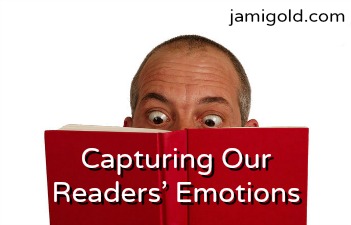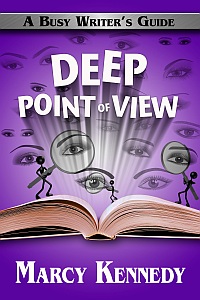I’ve often mentioned that one of the last big skills I learned as a writer was how to include emotions. That’s one reason I’ve been such a big fan of the Emotion Thesaurus. If that book had existed when I first started writing, my learning curve would have been several months shorter.
However, while Angela and Becca’s book (and their One Stop for Writers site) is great for giving us the vocabulary we need to describe our characters’ emotions, it’s also important for us to know the bigger picture of how we can evoke emotions in our readers.
For that, I’m bringing back Marcy Kennedy. As one of my editors, Marcy quickly proved herself as a genius with deep point of view. She can spot an out-of-point-of-view phrase from fifty paces and tell me exactly how to fix it.
Her latest writing craft book brings these two concepts together, so today she’s here to show us how deep point of view can help us evoke those emotions we want within our readers. Please welcome Marcy Kennedy! *smile*
*****
Using Deep POV to Capture
Readers’ Emotions
The books that we remember the best are often the books that made us feel something. Those are the books we recommend to our friends. Those are the authors we seek out to see if they have more books that will provide us with that vicarious experience again.
So it makes sense that when we create our own stories, we want to provide that same emotional experience for our readers too. *smile*
One great way to create emotional involvement in our readers is through deep POV.
What Is Deep POV?
Before I look at the ways we can use deep POV to tap into our readers’ emotional control centers, we need to talk about what we mean by deep POV.
Point of view (POV) in general is the perspective from which the story is told. We can write in omniscient POV, limited third person POV, second person POV, or first person POV.
The differences between the POVs aren’t just in terms of the pronouns we use (he/she vs. I). The choice we’re really making when we select the POV for our story is “where is the narrator standing when telling the story and how close do the readers feel to the narrator and the characters?”
On one end of the “sliding scale” of POV is the omniscient story. The narrator isn’t a character within the story itself. They sit outside the story and they’re essentially telling it to the reader. It’s the god-like perspective on the story where we hear the omniscient narrator’s opinion on everything. As readers, we’re held at a distance from the characters, watching them from the outside with only brief dips into their thoughts. (It’s often confused with head-hopping, but head-hopping and omniscient POV aren’t the same.)
On the other end, is deep POV.
In deep POV, we place the reader inside the narrator/viewpoint character using either a close limited third person or first person POV. Everything the reader receives is filtered through the viewpoint character. We see and sense the world through them, and only what they experience can appear on the page. Beyond this, the story isn’t told objectively. It’s all subjective and colored by the viewpoint character’s judgments, opinions, and feelings.
It’s intimate. It’s intense. And it’s very popular right now among readers and writers.
So how does deep POV capture readers’ emotions?
Deep POV Taps into the Shared Emotional Landscape with Visceral Reactions
To engage readers emotionally, we need to bring them back to when they felt the same emotions as our characters. Emotions are a universal experience. We all know what fear feels like. Or desire. Or hatred.
But it’s not enough to name the emotions. Naming emotions taps into our readers’ minds, but not into the way they felt when they were experiencing that emotion.
To tap into what those emotions feel like, we need visceral reactions.
Visceral reactions are a key element of what makes deep POV…well, deep because they’re the involuntary or instinctive bodily responses we have no control over—dizziness, a racing heart, sweaty palms, tense shoulders, a clenched stomach, etc. They’re a physical expression of the emotions the character is feeling.
When we share how a character’s body reacts, we trigger the reader to remember when their body felt the same way. And, just like that, they form an emotional connection with and empathy for your viewpoint character.
How to best use visceral reactions:
- Don’t overuse them. Think about visceral reactions as cayenne pepper. A dash adds a special bite to your dish. A scoop burns out your taste buds and ensures you won’t want to eat that dish again. If you’ve ever read a book where the character’s heart pounded so often you were worried they were about to have a heart attack, you know what I mean. Make sure to save them for important moments.
- Add variety. When we first start adding visceral reactions, it can be easy to default to phrases like “her heart pounded” and to repeat those pet visceral reactions too often. Our bodies react in a variety of ways, and we should make use of the full spectrum. The Emotion Thesaurus by Angela Ackerman and Rebecca Puglisi is a great tool to help with adding variety.
- Beware of interpreting them. Sometimes it’s alright to both show and tell, but this is the exception, not the norm. So when we’re adding visceral reactions, we should usually give the evidence and stop (e.g., her hands shook rather than her hands shook with fear). Context will allow the reader to understand them.
- Personalize it. One of the internal sensations for agitation is feeling overheated. How will our character describe that sensation? A middle-aged woman with a good sense of humor might think of it in terms of getting a taste of the hot flashes she’ll experience in menopause. A teenager might liken it to when the air conditioning broke—For Three. Whole. Days. Same sensation. Different points of view. Infinite possibilities.
- Remember that they’re always reactions to a stimulus. Unless we’re sick, we don’t just start shaking out of the blue. Something triggers that visceral reaction. Maybe it’s the thought that we left the gas stove on at home. Or maybe it’s that we spotted the ex who cheated on us in the next grocery aisle. They don’t happen without a reason, and the reader needs to see that reason.
Deep POV Makes the Reader Care about the Character Using Motivation Shares
Another hallmark of deep POV is motivation sharing—your character will reveal through their thoughts (a.k.a. internal dialogue, internal monologue, internalizations) why they’re doing what they’re doing and why it matters to them.
In more distant points of view, readers more often have to watch what the characters are doing and try to guess at their motivations. Knowing less about why the characters are acting the way they are might increase curiosity, but it also tends to make the reader less invested emotionally.
Say, for example, we’re writing a dystopian and we show a man breaking into a hospital and stealing antibiotics. We aren’t given the motivation.
Do we care about that character? Probably not. We might even dislike him, assuming that he’s stealing drugs to sell.
But if we’re writing in deep POV, we’ll share that his motivation is that his daughter is extremely sick and he can’t afford to pay for those antibiotics. His daughter’s value-quotient isn’t high enough for her to be treated for free. Now we start to care.
We care because we know why he wants this so badly. We’re emotionally invested in whether he succeeds or fails.
How to best use motivation sharing:
- Avoid infodump-style shares. We need to share their motivations, but we don’t need to do it all at once in a stop-the-action-dead information dump. We can weave it in with the action, drip-feeding it to the reader when the character would naturally think about it.
- Phrase the motivation in the way our character would think about it. We’re in deep POV so we need to share motivations in a natural way rather than in a in a telling or stating-a-fact way. If we go back to our example of the father stealing antibiotics, a telly motivational share would be something like he needed these drugs or his daughter would die. A natural motivation share would be him thinking about how her fever had spiked that morning.
- Only share motivations for non-obvious actions. If the bad guy throws a punch at our viewpoint character and she ducks, we don’t need to explain why she ducked. Any time our character’s motivations are obvious, we can trust the reader is intelligent enough to figure it out.
*****
About Deep Point of View: A Busy Writer’s Guide:
Do you want readers to be so caught up in your book that they forget they’re reading?
Then you need deep POV.
Deep POV takes the reader and places them inside of our characters—hearing their thoughts, feeling their emotions, and living the story through them. Compared to other writing styles, it builds a stronger emotional connection between the reader and our characters, creates the feeling of a faster pace, and helps avoid point-of-view errors and telling rather than showing.
In Deep Point of View, writing instructor and fiction editor Marcy Kennedy brings her years of experience into showing you how to write deep POV. You’ll learn specific, practical things you can do immediately to take your fiction to the next level.
*****
 Marcy Kennedy is a science fiction and fantasy author who believes there’s always hope. Sometimes you just have to dig a little harder to find it.
Marcy Kennedy is a science fiction and fantasy author who believes there’s always hope. Sometimes you just have to dig a little harder to find it.
She’s also the author of the bestselling Busy Writer’s Guides series, which focuses on giving authors deep teaching while still respecting their time.
You can find her blogging about writing and about the place where real life meets science fiction, fantasy, and myth on her website.
*****
Thank you, Marcy! Every one of your Busy Writer’s Guide books that I’ve read have been fantastic, and I can’t wait to dig into this new one. (Not having this fever would help my ability to understand it too. *grin*)
Every tip above is one that I had to learn or that I’ve seen other writers struggle with (or both). So hopefully seeing Marcy lay out these specifics will give us all a jump on our skill set and save us time on the learning curve. *smile*
Do you agree or disagree with Marcy’s perspective of what makes stories stick with us? What about how we evoke emotions in our readers? Questions from Marcy: Are you a fan of stories written in deep POV or do you prefer a more distant approach? Do you have any other tips you’d like to share for using deep POV to enhance readers’ emotional connection with the characters? Do you have any questions for Marcy?


